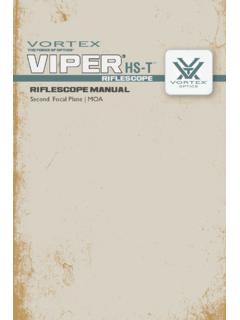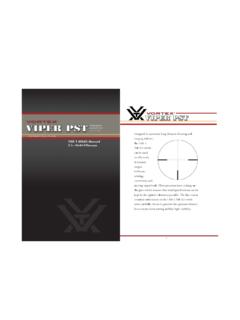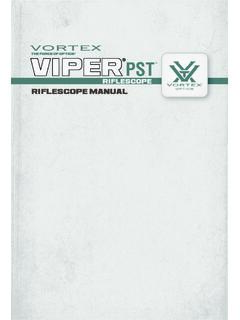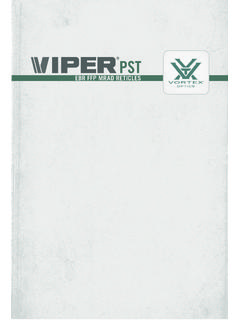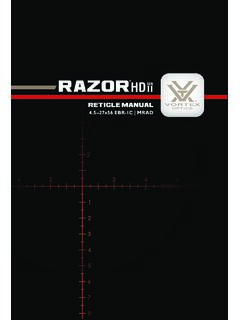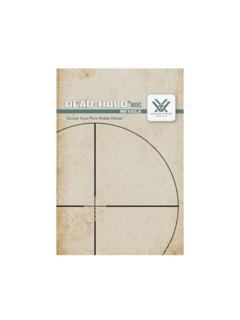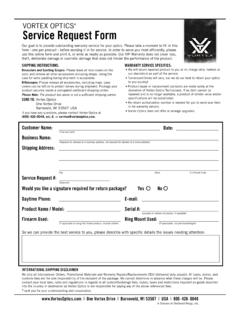Transcription of manual reticle vhs-vmr-1-moa-13b - Vortex Optics
1 VMR-1 reticle (mOA) second Focal Plane reticle ManualVMR-1 RETICLE3 2 RETICLEVMR-1 The Vortex VMr-1TM reTicleVMR-1 MOA ReticleYou have purchased a Vortex riflescope equipped with the VMR-1TM reticle . Designed to maximize long distance shooting and ranging abilities, the VMR-1 MOA reticle can be used to effectively determine ranges, holdovers, windage corrections and moving target leads. 5 4 RETICLEVMR-1 MOA SubtensionsVMR-1 SubtensionsSubtensions measured in MOA. reticle image shown for representation only. The VMR-1 reticle is based on minute-of-angle (MOA) subtensions. MOA measurements are based on degrees and minutes: 360 degrees in a circle, 60 minutes in a degree for a total of 21,600 minutes. These angular measurements are used to estimate range and correct for bullet trajectory drop in riflescopes. 1 MOA will correspond to inches at a 100 yard distance, inches at 200 yards, inches at 300 yards, and so Focal Plane reTicleSSecond focal plane (SFP) reticles are located near the scope s eyepiece behind the image erecting and magnifying lenses.
2 This style of reticle does not visually change in size when you change the magnification. The advantage of an SFP reticle is that it always maintains the same ideally-sized appearance. When shooting with this SFP scope, be aware that the listed reticle subtensions used for estimating range, holdover, and wind drift correction are accurate at the highest magnification for all models except the 6-24x50. For 6-24x50 models, the reticle subtensions are accurate at 6 RETICLEVMR-1 RangingRanging a target stand that is six feet (72 inches) tall at 8 MOA to get 860 x MOA860 Yards=ExampleMOA measurements are very effective for ranging using a simple formula. To use this formula, the shooter needs to know the size of the target, or nearby object, in inches. Using either the vertical or horizontal MOA scale, place the reticle on a target of known dimensions and read the number of MOAs spanned.
3 You will obtain maximum accuracy in ranging by calculating exact MOA measurements. MOAs should be estimated in 1/2s if possible. Accurate measuring will depend on a very steady hold. The rifle should be solidly braced using a rest, bipod or sling when measuring. Once you have an accurate MOA reading, use the formula to calculate the Size (incheS) x MoaSrange (YardS)=Moa ranging ForMula9 8 RETICLEVMR-1 Elevation HoldoversOnce the distance has been calculated using the VMR-1 or a laser rangefinder, the VMR-1 can be used for rapid holdover correction of the bullet drop. To get the most benefit out of the riflescope equipped with the VMR-1 reticle , Vortex Optics highly recommends shooters learn their bullet drop numbers and windage/lead corrections in MOAs rather than inches or mrads. Remember that 1 MOA will correspond to inches at a 100 yard distance, inches at 200 yards, inches at 300 yards, and so on.
4 Since this VMR-1 reticle is marked in MOA, it is an easy job to quickly select the correct drop reference line once the shooter knows the bullet drops and windage/lead corrections in MOAs. If the shooter prefers to dial the come ups for bullet drop using the elevation knob, knowing bullet drops in MOAs will allow for much faster adjustments because the MOAs can be quickly read on the elevation MOA reticle holdover correction for 600-yard shot. No 10 RETICLEVMR-1 Windage and Moving TargetsThe VMR-1 reticle is highly effective when used for wind and moving target leads. Using the reticle for effective windage and moving leads will require a thorough knowledge of your cartridge s ballistic performance under varying conditions and experience in reading wind strengths and target speeds. As in bullet drops, it is imperative the shooter learn their particular weapon s windage/moving target corrections in MOAs rather than inches or mrads.
5 Always hold the reticle into the wind when correcting for wind dialing elevation come ups, the center horizontal crosshair will be used for windage or moving target leads. MOA marks on the horizontal and vertical crosshairs are graduated in 2 MOA windage correction on center crosshair10 MOA reticle correction for 20 mph wind at 700 yards. Elevation is already dialed into turret. 20 mph windFull value wind at 90 degreesExampleWhen dialing elevation come ups, the center horizontal crosshair will be used for windage or moving target leads. MOA marks on the horizontal crosshair are graduated in 2 MOA 12 RETICLEVMR-1 When estimating moving target leads, the MOA marks on the center horizontal crosshair can be used. Estimating moving leads will require knowing yardage distance, wind speed, moving target speed and total bullet flight times including rifle lock time.
6 Bullet flight times can be roughly calculated based on fps velocities or a ballistic moving lead correctionNote: Correctly estimating moving leads is very difficult and requires considerable practice and knowledge beyond the scope of this MOA reticle correction for a target moving 3 mph at a distance of 800 yards. No wind. Total bullet time of flight from moment of trigger pull is seconds during which a target travels feet. Elevation already dialed into DirectionExampleHS-T
